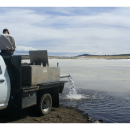Due to half a century of collaborative conservation efforts between tribal, state, federal, and non-governmental organizations, the Apache trout has a brighter and more sustainable future. The U.S. Fish and Wildlife Service (Service) is announcing today the completion of a five-year status review which recommends delisting the species from the Endangered Species Act (ESA).
The next step by the Service will be to publish a proposed rule in the Federal Register to delist the Apache trout. The proposed rule, expected to publish by the end of 2022, will include a 60-day public comment period seeking input from state, federal, tribal, and other government agencies, the scientific community, industry, or any other interested parties concerning the proposed delisting.
“We would like to thank our partners for their engagement and collaborative efforts alongside the Service towards the recovery of the Apache trout,” said Amy Lueders, Regional Director for the Service. “We are excited to say the recovery actions by the White Mountain Apache Tribe and other partners have led to the recommendation to delist the species from the ESA.”
The implemented conservation actions, such as non-native trout removal, fish barrier construction, and Apache trout reintroductions, made recovery possible, and will continue to drive conservation. The Service is committed to the continued conservation of the Apache trout, whether the fish is delisted or not.
The Service, along with White Mountain Apache Tribe, Arizona Game and Fish Department, USDA Forest Service, and Trout Unlimited share responsibilities under a 2021 Apache Trout Cooperative Management Plan. That plan outlines goals to reach recovery and delisting of the Apache trout, and if delisted to maintain a recovered status, while providing sportfishing opportunities.
Apache trout is Arizona’s state fish and is native exclusively to the streams around the White Mountains in the eastern part of the state. It was originally considered the same species as the Gila trout, which was listed under the Endangered Species Preservation Act in 1967. Apache trout was first described as a unique species separate from Gila trout in 1972. A year later, it gained protection under the Endangered Species Act of 1973, and it was subsequently downlisted to threatened in 1975.
This five-year review was informed by a 2021 species status assessment (SSA), which includes the best available scientific information. The assessment evaluated the species' current needs, conditions, and threats, in addition to modeling future scenarios. It also involved contributions from scientific experts, including an independent peer review and review by federal and state partners. More information about five-year status reviews is available on our website.
The first recovery plan for the Apache trout was developed in 1979, a revised plan was developed in 1983, and a second revision was completed in 2009. A main goal of the recovery plan is to reach 30 genetically pure populations of Apache trout, with habitat sufficient to support self-sustaining populations. The SSA developed by biologists from White Mountain Apache Tribe, Arizona Game and Fish Department, USDA Forest Service, Trout Unlimited, and the U.S. Fish and Wildlife Service confirms that the goal of 30 genetically pure self-sustaining populations has been reached.
A major threat to Apache trout populations has been the introduction of non-native trout. The gene pool was threatened by hybridization with non-native rainbow and cutthroat trout. Additionally, non-native brook and brown trout pose threats through competition and predation. Much of the conservation work has involved removing these introduced trout from Apache trout habitat and constructing barriers to block further non-native introductions. Additionally, thanks to over $2 million from the Bipartisan Infrastructure Law Bipartisan Infrastructure Law
The Bipartisan Infrastructure Law (BIL) is a once-in-a-generation investment in the nation’s infrastructure and economic competitiveness. We were directly appropriated $455 million over five years in BIL funds for programs related to the President’s America the Beautiful initiative.
Learn more about Bipartisan Infrastructure Law ’s National Fish Passage Program, Service partners are working to remove certain barriers that are no longer needed thanks to non-native trout removal. This will open 52 stream miles of Apache trout habitat for new populations.
The five-year review and additional information about the Apache trout is available on the species ECOS page. (Direct link.)
The Service remains interested in information regarding the status and conservation of, and any potential threat to, the Apache trout. Please submit information by email to incomingazcorr@fws.gov.




